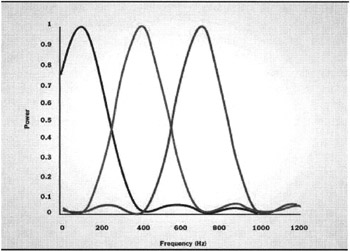OFDM
|
| < Day Day Up > |
|
The other modulation technique that plays a large part in the IEEE 802.11 series of standards for wireless LANs is orthogonal frequency division multiplexing (OFDM). OFDM is a digital modulation method in which a signal is split into several narrowband channels at different frequencies. The technology was first conceived in the 1960s and 1970s during research into minimizing interference among channels near each other in frequency. Both 802.1 la and 802.11g use OFDM.
With OFDM, priority is given to minimizing the interference, or crosstalk, among the channels and symbols comprising the data stream. Less importance is placed on perfecting individual channels. In some respects, OFDM is similar to conventional frequency division multiplexing, although the way the signals are modulated and demodulated differ.
The demand for high-speed wireless networking exposed the limits of spread spectrum technologies. Because of their relatively inefficient use of bandwidth, the original spread spectrum systems cannot satisfy the higher data rates that technology operating in the 5 GHz U-NII bands can accommodate. That is why the more efficient and robust OFDM was added to the Wi-Fi modulation mix. OFDM, sometimes referred to as multi-carrier or discrete multi-tone modulation, utilizes multiple sub-carriers to transport information in from one particular user to another. An OFDM-based system divides a highspeed serial information signal into multiple lower-speed sub-signals that the system transmits simultaneously at different frequencies in parallel.
The benefits of OFDM are high spectral efficiency, resiliency to RF interference, and lower multi-path distortion. The orthogonal nature of OFDM allows sub-channels to overlap, having a positive effect on spectral efficiency (see Fig. 5.5). Each one of the sub-carriers transporting information is just far enough apart from each other to theoretically avoid interference.

Figure 5.5: The orthogonal nature of OFDM's efficient use of bandwidth.
This parallel-form of transmission over multiple sub-carriers enables OFDM-based WLANs to operate at higher aggregate data rates, such as up to 54 Mbps with 802.11a/11g-compliant implementations. In addition, interfering RF signals will only destroy the portion of the OFDM transmitted signal related to the frequency of the interfering signal.
| Note | The better the quality of the signal at 5 MHz, the more complex the modulation technique that can be supported within each sub-carrier channel and the more bits, therefore, can be impressed on the RF signal. The coding techniques and data rates that are specified to work in tandem with OFDM in 802.11a include BPSK at 125 Kbps per channel for a total of 6 Mbps across all 48 data channels, QPSK at for 250 Kbps per channel for a total of 12 Mbps, 16QAM (16-level quadrature amplitude modulation) at 500 Kbps per channel for a total of 24 Mbps, and 64QAM (64-level QAM) at 1.125 Mbps per channel for a total of 54 Mbps. |
OFDM exhibits lower multipath distortion (delay spread), since the high-speed composite's sub-signals are sent at lower data rates. Because of the lower data rate transmissions, multipath-based delays are not nearly as significant as they would be with a single-channel high-rate system. For example, a narrowband signal sent at a high rate over a single channel will likely experience greater negative effects from delay spread because the transmitted symbols are closer together.
In fact, the information content of a narrowband signal can be completely lost at the receiver if the multipath distortion causes the frequency response to experience a null at the transmission frequency. The use of the multi-carrier OFDM significantly reduces this problem.
Multipath distortion can also cause inter-symbol interference, which occurs when one signal overlaps with an adjacent signal. OFDM signals typically have a time guard of 800 nanoseconds (ns), however, which provides good performance on channels having delay spreads up to 250 ns. This is good enough for all but the harshest environments. Delay spread due to multi-path propagation is generally less than 50 ns in homes, 100 ns in offices, and 300 ns in industrial environments.
Many wired and wireless standards bodies have adopted OFDM for a variety of applications. For example, OFDM is used in European digital audio broadcast services. The technology also lends itself to digital television, and OFDM is the basis for the global Asymmetric Digital Subscriber Line (ADSL) standard. ADSL uses a variant of OFDM called discrete multi-tone (DMT), where the system sends several sub-carriers in parallel using the Inverse Fast Fourier Transform (IFFT) technique and receives the sub-carriers using the Fast Fourier Transform (FFT) techniques. In wireless LANs, OFDM is at the heart of the IEEE 802.1 la and g specifications and European HiperLAN/2 standard. All implement OFDM in a similar way with the main difference being how the standards perform convolutional encoding.
|
| < Day Day Up > |
|
EAN: 2147483647
Pages: 273
- Chapter VII Objective and Perceived Complexity and Their Impacts on Internet Communication
- Chapter X Converting Browsers to Buyers: Key Considerations in Designing Business-to-Consumer Web Sites
- Chapter XII Web Design and E-Commerce
- Chapter XIII Shopping Agent Web Sites: A Comparative Shopping Environment
- Chapter XVII Internet Markets and E-Loyalty